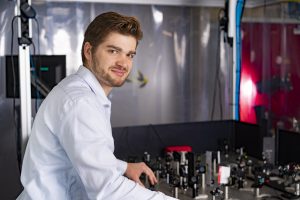Peter Kraus takes next step towards application with ERC Proof of Concept grant
The research group of Peter Kraus receives an ERC Proof of Concept grant amounting 150 k€ to bring the innovation of Kraus’ ERC Starting grant on correlated materials closer to the application stage. The new project is called ‘Super-resolution microscopy for semiconductor metrology’ (MICROSEM).

High-harmonic generation benefits
Kraus and his team work on so-called high-harmonic generation, a method that makes it possible to more efficiently study the nanometer scale structures used in the semiconductor industry. An efficient production process requires constant quality inspection of the printed features, either directly on the integrated circuits or on dedicated metrology targets. Recently, Kraus and his team have shown that by generating high-harmonics from these structures, nanometer scale details can be visualized, often dubbed super-resolution. Contrary to previous super-resolution approaches they no longer have to label or chemically modify the sample. This also creates opportunities for many disciplines in science and engineering that currently cannot benefit from super-resolution microscopy because labeling is not an option.
How it works
How can super resolution via high-harmonic generation from solid structures be achieved? Kraus and his team demonstrated that high-harmonic generation – that is the frequency upconversion of laser pulses – can be optically suppressed and spatially confined in semiconductors. This can be utilized as emission from a nanometer spot for super-resolution scanning microscopy. Kraus will further develop this technique in order to reach a resolution below 100 nanometer in a conventional optical microscope operating in the visible and ultraviolet region, without the need of complicated vacuum equipment. This will enable crucial applications for semiconductor wafer metrology.








